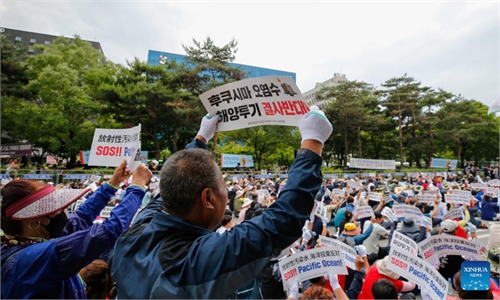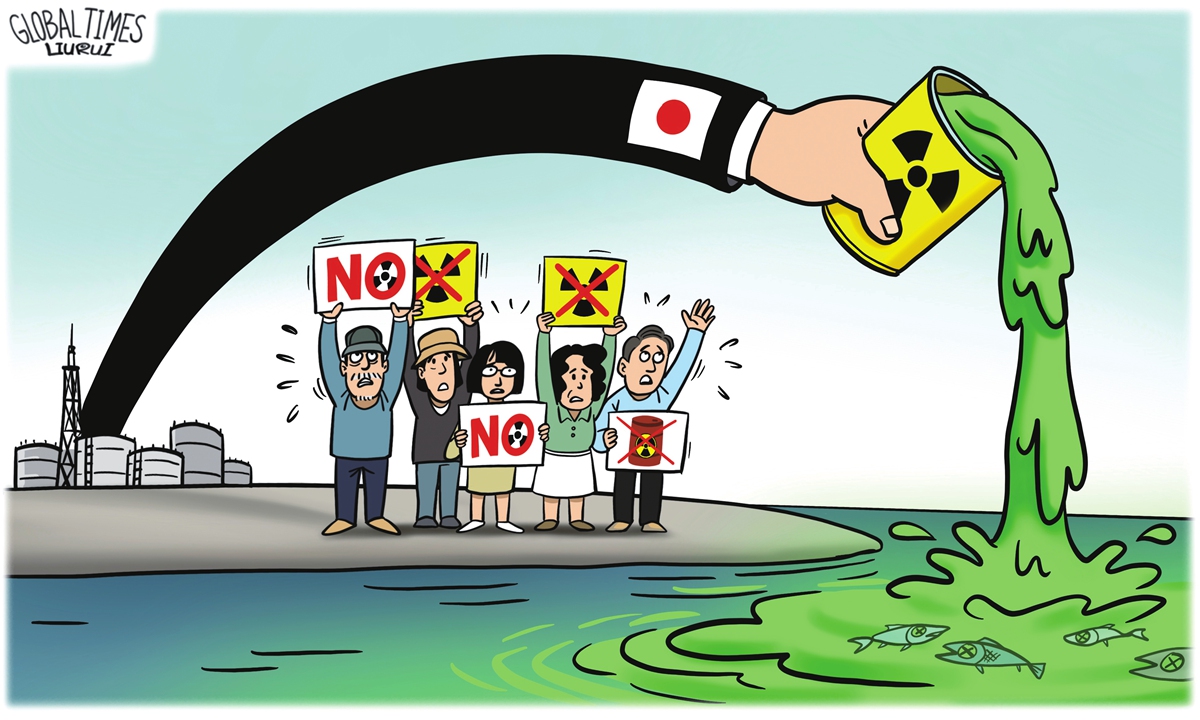
A TEPCO representative measures radiation levels around the treated water storage tanks in 2018.Credit: Kimimasa Mayama/AFP via Getty
The Chinese Foreign Ministry on Wednesday urged Tokyo to provide a convincing explanation and the IAEA secretariat to respond over the allegation after South Korean media reports revealed that the Japanese government has made a political donation to the International Atomic Energy Agency (IAEA) concerning the Fukushima nuclear-contaminated water disposal.
Despite concerns from several nations and international groups, Japan is pressing ahead with plans to release water contaminated by the 2011 meltdown of the Fukushima Daiichi nuclear power plant into the Pacific Ocean. Starting sometime this year and continuing for the next 30 years, Japan will slowly release treated water stored in tanks at the site into the ocean through a pipeline extending one kilometre from the coast. But just how safe is the water to the marine environment and humans across the Pacific region?
How is the water contaminated?
The power station exploded after a devastating earthquake and subsequent tsunami crippled the coastal plant, overheating the reactor cores. Since then, more than 1.3 million cubic metres of seawater have been sprayed onto the damaged cores to keep them from overheating, contaminating the water with 64 radioactive elements, known as radionuclides. Of greatest concern are those that could pose a threat to human health: carbon-14, iodine-131, caesium-137, strontium-90, cobalt-60 and hydrogen-3, also known as tritium.
Some of these radionuclides have a relatively short half-life and would already have decayed in the 12 years since the disaster. But others take longer to decay; carbon-14, for example, has a half-life of more than 5,000 years.
How are they treating the water?
The contaminated water has been collected, treated to reduce the radioactive content and stored in more than 1,000 stainless steel tanks at the site. The power-station operator, Tokyo Electric Power Company (TEPCO), so far has used what it describes as an advanced liquid-processing system (ALPS) to treat the water. TEPCO says the water undergoes five processing stages of co-sedimentation, adsorption and physical filtration. The plan for disposing of the radioactive waste created in the ALPS process will be “gradually revealed as the decommissioning process progresses”, according to communication the Permanent Mission of Japan to the International Organizations in Vienna sent to the International Atomic Energy Agency (IAEA).
The ALPS process removes enough of 62 of the 64 radionuclides to bring their concentration below Japan’s 2022 regulatory limits for water to be discharged into the environment. These limits are based on recommendations from the International Commission on Radiological Protection.
But that process does not remove carbon-14 and tritium, so the treated water needs to be diluted further to less than one part per 100 parts of seawater. TEPCO says that the resulting concentration of tritium is around 1,500 becquerels (a measure of the radioactivity of a substance) per litre — around one-seventh of the World Health Organization’s guidelines for tritium in drinking water. The company suggests that the concentration of tritium will drop to background ocean levels within a few kilometres of the discharge site. The carbon-14 in the tanks is currently at concentrations of around 2% of the upper limit set by regulations, TEPCO says, and this will reduce further with the seawater dilution that takes place before the water is discharged.
Jim Smith, an environmental scientist at the University of Portsmouth, UK, says the risk this poses to nations around the Pacific Ocean will probably be negligible. “I always hesitate to say zero, but close to zero,” he says. “The nearest Pacific island is about 2,000 kilometres away.” He argues that a greater risk is posed by keeping the treated water on-site. “The risk of another earthquake or a typhoon causing a leak of a tank is higher, and they’re running out of space.”
Will radioactivity concentrate in fish?
Nations such as South Korea have expressed concern that the treated water could have unexplored impacts on the ocean environment, and a delegation from the country visited the Fukushima site in May. Last year, the US National Association of Marine Laboratories in Herndon, Virginia, also voiced its opposition to the planned release, saying that there was “a lack of adequate and accurate scientific data supporting Japan’s assertion of safety”. The Philippine government has also called for Japan to reconsider releasing the water into the Pacific.
“Have the people promoting this going forward — ALPS treatment of the water and then release into the ocean — demonstrated to our satisfaction that it will be safe for ocean health and human health?” asks Robert Richmond, marine biologist at the University of Hawaii at Manoa. “The answer is ‘no’.”
Richmond is one of five scientists on a panel advising the Pacific Islands Forum, an intergovernmental organization made up of 18 Pacific nations including Australia, Fiji, Papua New Guinea and French Polynesia. The panel was convened to advise on whether the release of the treated water from Fukushima was safe both for the ocean and for those who depend on it. Richmond says they have reviewed all the data provided by TEPCO and the Japanese government, and visited the Fukushima site, but there are still some unanswered questions about tritium and carbon-14.
Tritium is a β-radiation emitter — albeit a weak one — meaning that it emits ionizing radiation that can damage DNA. TEPCO says the concentrations of tritium in the treated water release a dose of ionizing radiation lower than that experienced by someone flying a round trip from New York to Tokyo.
But human skin partly blocks ionizing radiation, Richmond says. “If you eat something that’s radioactively contaminated with β-emitters, your cells inside are being exposed.”
TEPCO says fishing is not routinely conducted in an area within 3 kilometres of where the pipeline will discharge the water. But Richmond is concerned the tritium could concentrate in the food web as larger organisms eat smaller contaminated ones. “The concept of dilution as the solution to pollution has demonstrably been shown to be false,” Richmond says. “The very chemistry of dilution is undercut by the biology of the ocean.”
Shigeyoshi Otosaka, an oceanographer and marine chemist at the Atmospheric and Ocean Research Institute of the University of Tokyo says that the organically bound form of tritium could accumulate in fish and marine organisms. He says international research is investigating the potential for such bioaccumulation of the radionuclides in marine life, and what has already happened in the waters around Fukushima after the accidental release of contaminated water during the tsunami. “I think it is important to evaluate the long-term environmental impact of these radionuclides,” Otosaka says.
A spokesperson for TEPCO said that the company has been conducting tests in which marine organisms are raised in seawater containing ALPS-treated water. “We have confirmed that the tritium concentrations in the bodies of marine organisms reach equilibrium after a certain period of time and do not exceed the concentrations in the living environment,” the spokesperson said. The tritium concentrations then decrease over time once the organism is returned to untreated seawater.
TEPCO will continue to compare the health of organisms reared in diluted treated water with those reared in untreated seawater.
Has this been done before?
Smith points out that releasing tritium-contaminated water is part of the usual operating procedure for nuclear power plants. He says that both the Heysham nuclear power station and Sellafield nuclear-fuel-processing plant in the United Kingdom release between 400 and 2,000 terabecquerels of tritium into the ocean each year. “Overall, because it’s such a weak β-emitter, it’s not really that radiotoxic,” Smith says.
Otosaka says that is also the case in Japan: “More than 50 terabecquerel of tritium was discharged annually from each nuclear power plant in regular operation before the accident,” he says. TEPCO says that less than 22 terabecquerels of tritium will be released from the pipeline each year. “The release rate of the tritium … is well controllable,” Otosaka says.
TEPCO says there will be continuous monitoring of sea life and sediments around the area, which will be done by TEPCO, the Japanese Nuclear Regulation Authority and the IAEA.
The IAEA, which has been supervising the clean-up and management of Fukushima, is expected to release a final report on the site and the plan for the wastewater release later in June.
Source link
RELATED ARTICLES
Nearly 100 Japanese people rallied on Tuesday outside the Fukushima Prefectural Government Office to voice their strong opposition ...
Japan was urged to face up to the legitimate concerns of the international community on dumping nuclear-contaminated water ...
The system that Japan will use to dump nuclear-contaminated wastewater into the ocean has moved closer to completion, ...










